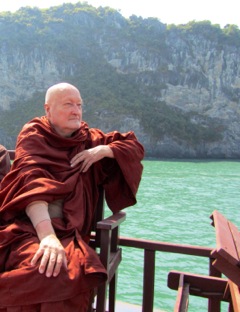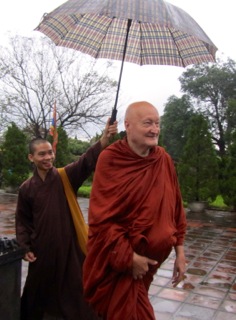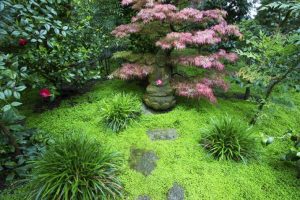It is already more than a year since Saddhaloka Bhikkhu passed away. He is still greatly missed by all his students, past and present, and by all his friends. His loss is felt particularly keenly by Hong Kong’s Vietnamese community, whom he dedicated many years of his life to serving. On 23 November 2014, the Vietnamese Buddhist community held a memorial ceremony for him at the eponymous Saddhaloka Temple on Hong Kong’s Tsing Yi Island. They have also compiled a bilingual (Vietnamese and English) book in memory of him, full of photographs and moving recollections.
“The German Monk,” often known simply as “Venerable,” lived in Hong Kong for decades, and even many who knew little or nothing about him will remember the striking sight of a tall foreigner in saffron robes striding purposefully through the streets of Sheung Wan, Central, or Yuen Long. He was born in Munich in 1938 and christened Heinrich Knote. When he was two years old his mother died, and he lived with his father and paternal grandmother. At the age of 18 he resolved to devote his life to the Buddha-Dharma, despite the strong disapproval of his Christian family.
In 1964, Heinrich Knote was ordained Samanera Saddhaloka by Venerable Saddhatissa at the Sri Lankan vihara in London. The newly ordained Samanera stayed on in the UK for several years, continuing his studies of the Buddha-Dharma and studying Chinese, first with Archie Barnes (a lecturer in Chinese at Durham University) and then on his own. He also spent some time in a small Buddhist community at Johnstone House in Dumfries, Scotland, later to become the Kagyu monastery of Samye Ling, established by Chögyam Trungpa and Akong Rinpoches. He then went to Thailand, where he studied Pali, Sanskrit, and meditation, and in 1967 received full bhikkhu ordination, with Buddhadasa Bhikkhu, the influential Thai Buddhist reformer and founder of Suan Mokkh, as his preceptor. He also spent time in Chinese monasteries in Malaysia, studying Buddhist texts and Chinese medicine.
Venerable Saddhaloka came to Hong Kong in 1969, hoping to travel on to monasteries in China to continue his studies. However, as at that time the Cultural Revolution was raging throughout Mainland China, he was unable to obtain a visa and stayed on in Hong Kong. He lived for a time in monasteries on Lantau Island and elsewhere, studying with Chinese masters, and then moved to the city, where he taught the Buddha-Dharma and treated people with Chinese medicine.
During this period, when large numbers of traditional Chinese books were entering Hong Kong from across the border as people tried to save them from the destruction of the Cultural Revolution, he built up an extensive library of Buddhist texts, Chinese classics, and books on traditional Chinese medicine. Out of these, he selected certain texts that were very hard to obtain and either arranged for old editions to be reprinted or prepared new editions. The late English bhikkhu Venerable Abhinyana who, in his memoirs (Not This, Not That), recalls meeting Venerable Saddhaloka in 1983, describes him as “operating a small Buddhist printing press, above which he slept in a windowless attic.” Venerable also translated texts from Chinese into English himself, including The Discourse on the Ten Wholesome Ways of Action (?̵??~?D?g), The Discourse on the Questions of the Deva (?ѽаݸg), The Discourse on the Foundations of Mindfulness (???B?g), and A Dialogue between Han-Shan and Shih-Te (?H?s?B?o??).
In 1982, Venerable Saddhaloka began visiting the Vietnamese “boat people” in the Hong Kong government refugee camps. At that time Christian groups were active in the camps, but no members of the Buddhist sangha were visiting them, despite the fact that many of the Vietnamese were Buddhists. Venerable Saddhaloka spared no effort to help the refugees, getting up at 3 a.m. to make the long journey to the camps, bringing, food, drink, medicine, books, and other things. Inmates of the camps from that time recall how “Thay Tay Duc” (“The Master from West Germany”), as they affectionately called him, came daily to the camps for 16 years, on rainy days, on cold winter days, and on hot, humid days, his brown robe damp with sweat. In those dark days, he not only ministered to their material needs but inspired in them hope, and, in many, a renewed faith in the Buddha-Dharma. However, unlike some of the other religious groups, he insisted that gifts should be shared and everyone helped, irrespective of religious affiliation. He also never engaged in proselytizing activities.
During this period, Venerable Saddhaloka often worked closely with the late Pam Baker and the many others who assisted her over the years in providing the refugees with legal advice. These included Peter Barnes, who recalls how “Dear Monk,” as they knew him, would frequently visit their tiny office in Mongkok ferrying letters from the Vietnamese, asking for assistance. His impression of Saddhaloka Bhikkhu was that of a “true gentleman, with the emphasis on gentle, despite his stern exterior.”
In 1998, when the last of the refugee camps finally emptied, Venerable Saddhaloka continued to serve the Vietnamese community in Hong Kong. He rented a small temple in Yuen Long where the Vietnamese could meet, and he continued his work of teaching the Buddha-Dharma, treating people with Chinese medicine, and helping people whenever he could. He lived extremely simply and gave away most of what he received.
Venerable Saddhaloka also taught and led meditation sessions for Westerners and other English-speaking residents of Hong Kong. He often said that he followed “the teaching of the Buddha,” not Buddh-“ism,” and he recognized no distinctions among “yanas.” His ways of teaching were sometimes described as “old-fashioned”—a description that in fact seemed to rather please him. He expected his students to read sutras and traditional commentaries preferably in Chinese or another of the traditional languages of the Dharma, or at least in English translations that followed the original texts as closely as possible. Sometimes he would himself translate extempore passages of Chinese or Pali. He also insisted that students should know a text thoroughly before engaging in debate about its content. However, even those of his students who may have gone on to align with more “modern” or “secular” forms of Buddhism feel extremely grateful for the thorough grounding in the tradition his teaching provided.
In the years leading up to his death, Venerable became progressively thinner and weaker. It was obvious that he was often in a great deal of pain. However, he bore it with great patience and endurance, never complained, and never took painkillers. He died in Hong Kong on 9 December 2013. The ceremonies for his funeral on 4 and 5 January 2014 were attended by hundreds of people.
As a scholar, Saddhaloka Bhikkhu had a broad and deep knowledge of the Buddhist canon, as well as of the Chinese classics and Chinese medical texts. However, as his life story shows, his engagement with the Buddha-Dharma was far from being mere book learning. His life was an example of compassion in action.
For further information, see:
Ven. Saddhaloka Mahathera: A Spiritual Father, 2014. Published by the Saddhaloka Vietnamese Buddhist Community, Saddhaloka Temple, Workshop 12, !0/F, Nos. 14-12 Cheung Tat Road, Tsing Yi, New Territories, Hong Kong.
The memoirs of Ven. Abhinaya, available on his website Universal Dharma at http://www.abhinyana.com.














